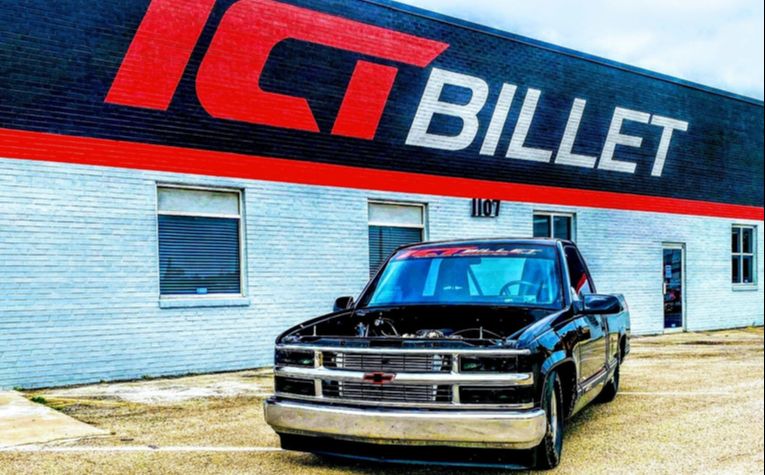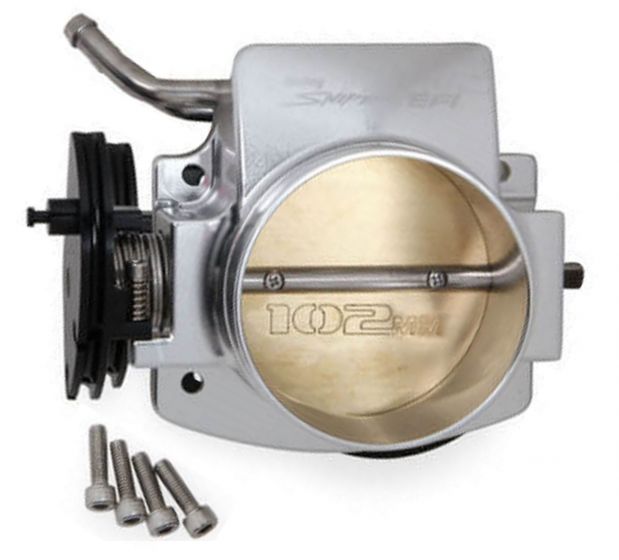What Throttle Body Should You Choose for Your LS Swap?

What Throttle Body Should You Choose for Your LS Swap?
YOU HAVE MULTIPLE OPTIONS FOR YOUR THROTTLE BODY APPLICATION. LEARN WHICH IS BEST.
Different generations of LS engines were made with different throttle body styles. As the LS evolved over time, so did their throttle bodies, becoming more efficient and much easier to tune. With the introduction of the original LS engine in 1997, throttle body configurations have ranged from cable driven to drive by wire (electronic), to three and four bolt, and even up to bigger throttle bodies such as the 102mm.
This means you have multiple options when it comes to choosing the best throttle body for your LS swap, and if you’re looking for extra power, picking the right throttle body has the ability to make that happen.
SEE ALSO: ICT BILLET LS SWAP GUIDE FOR GEN III & GEN IV
LS1 Throttle Bodies & Adapters
The LS1 engine was the first of its kind and features a three bolt throttle body, which means the throttle body bolts to your intake using only three bolts. For these early LS engines, like those found in the C5 Corvette, the throttle body design features the three bolt configuration with a 78mm blade.
The very first LS throttle body was an electronic throttle, also known as drive-by-wire. The electronic throttle was released before the cable throttle, but in 1998, the LS1 engine for both Camaros and Firebirds moved to cable throttle. It’s also important to note that the LS1 AND LS6 engines have the same equipment when it comes to the throttle body.
Modification Note: LS1 engines have a coolant pipe that’s plumbed through their bottom side. This is to assist with cold climate drivability. However, a popular modification to this setup is to bypass this in order to reduce heat in the intake.
So, let’s say you have an LS1 engine with a three bolt manifold, but you want to use a four bolt throttle body. Is that possible?
Absolutely! In fact, there are throttle body adapters created for that specific purpose so that you can retrofit your larger four bolt on your current three bolt. This is an especially popular upgrade for forced induction applications. But keep in mind: If you are adapting a three bolt to a four bolt, you will also need a wiring harness adapter.

LS2 Throttle Bodies & Adapters
The newer generation throttle bodies, such as the LS2, are four bolt. The LS2 was introduced as the base engine for the 2005 C6 Corvette and featured a new four bolt design with a larger 90mm silver blade. The electronics for these LS2 throttle bodies were contained internally using a single six wire connector.
Where the LS1 has a coolant pipe plumbed through the underneath side, the LS2 engine eliminated the coolant pipe entirely, along with the PCV vent. This design feature was much appreciated and served as a valuable improvement for LS enthusiasts from the previous engine model.
LS2 throttle bodies can get a little tricky depending on which vehicle you’re swapping. An LS2 throttle body is designed to work with vehicles ranging from 2008 and older that are equipped with E40 and earlier PCMs.
However, LS2 and some early 2008 LS3 engines utilize the same throttle body. At approximately the middle of the 2008 production run is when LS3 cars switched to a different setup. For these LS2 and early 2008 LS3 engines, you’ll notice the blade on the throttle body is silver. Later model 2008 LS3 throttle bodies are not interchangeable with the LS2 throttle body because the blade itself rotates in the opposite direction, and the computer programming is different between the two.
LS3 Throttle Bodies & Adapters
After the initial production of cars in 2008 featuring the LS motor, the LS3 engine switched from the silver blade LS2 throttle body to a gold blade that rotates opposite of the initial silver blade. This change was brought about originally for the Corvette engine and was later followed by the Camaro SS in 2010.
The gold blade is a noticeable difference between the LS3 and LS2 throttle body, but the LS3 also features a slightly different port shape than its predecessor. These LS3 throttle bodies were created to work with an E38 PCM. If you’re looking for a more impressive throttle response, you’ll be happy to learn that you can get a ported version of the LS3 throttle body to achieve this result.
Another noteworthy point on the throttle body for LS3 engines is that 2009 and newer engines have the same throttle body as the LS7.
Keep in mind: If you’re trying to use an LS2 throttle body on an intake manifold designed for the newer, gold blade LS3 throttle body, the bolt pattern and gasket are the same, but the blade opens in the opposite direction. So make sure you know which throttle body you need before you order parts for your swap.

Drive By Wire vs Drive By Cable Throttle Bodies
DRIVE BY CABLE (DBC)
Drive by Cable is the more common of the two types of throttle body configurations. This is mainly due to the fact that there is a mechanical linkage that flows directly from the throttle pedal to the throttle body itself.
The way a Drive by Cable system works is that the cable travels all the way to the throttle pedal on your car, and as you push down on the pedal to accelerate, the cable pulls to open up your throttle blade. This configuration offers an instant response, which is preferred by many LSX owners.
The Drive by Cable system features a throttle position sensor as well as an idle air control (IAC) valve. This system will easily connect to an existing throttle pedal and allow you to route a cable to your throttle body in an LS swap.
DRIVE BY WIRE (DBW)
Where Drive by Cable has the auxiliary throttle position and IAC sensors, the Drive by Wire setup features a servo motor that controls the position and how far the throttle blade opens up. The throttle position and IAC sensors in a Drive by Wire are located within the servo motor itself.
Drive by Wire works through an accelerator pedal that’s mounted under the dash in your vehicle. This pedal connects to your automotive’s computer via your wiring harness, and the wiring harness then connects to the servo motor on your throttle body, telling it how far to open based on the inputs the computer is receiving.
The great thing about Drive by Wire is that your car’s computer can progressively open the throttle blades at different rates. You can also program and adjust it to your specific needs and preferences based on your vehicle and how you’ll be using it.
Drive by Wire won’t connect to an existing cable throttle pedal, but the electronic accelerator pedal and wires are easily hidden, giving you a cleaner look.
Choosing the Throttle Body & Throttle Body Adapter You Need
There are several things to consider when it comes to choosing the throttle body and adapters that you need for your LS swap. We hope this blog has provided you with ample information to decide what will work best with your configuration.
One more thing to note before selecting your throttle body is that, as we mentioned above, some have an IAC (idle air control) valve in the throttle body itself that controls idle airflow. The newer blades do not. They actually control idle airflow by simply tipping the blade to a commanded point.
ICT Billet makes all kinds of adapters to make pretty much any throttle body work with your application. We offer spacers, harness extensions, and adapters that let you run a three bolt to a four bolt intake or a 4 bolt throttle body to a three bolt intake.
Need help figuring out which throttle body and adapters you need? We’re happy to help! Simply give us a call at 316-300-0833 or fill out our online contact form and one of our team members will respond shortly.
In the meantime, check out our line of throttle body accessories at ICT Billet. We’re proud to provide you with all American-made products, built from premium materials, and priced affordably so that you can make your next build the best it can be.


